Paula R.C. Readman's Blog, page 45
May 5, 2021
A Class Of Distinction
To me education is a treasure. A buried treasure. Something to seek out and hunted down. Like anything of high value it doesn’t come easily to all, and can cost the earth too. With that in mind, I wasn’t expecting to walk away with an English degree when I signed up at my local college for some evening classes in Brush Up English: basic skills in 2006, but I was expecting more than what I actually received.
Yes, the classes were free. The government at that the time wanted to improve adult literacy and numeracy in Britain. The courses were paid for by the taxpayers, and as I worked full-time and paid my taxes, were I not entitled to learn too. I hoped the evening classes would improve my understanding of English Grammar and help build my confidence, or at least give me something I could build on, to increase my understanding of how grammar worked. I saw it as a building block to a better future.
 Photo by Baljit Johal on Pexels.com
Photo by Baljit Johal on Pexels.comClass 6 of 32: A Class of Distinction.
After having an evening off from my classes, I was looking forward to getting back. This seemed strange somehow. When I compared returning to my evening classes, after the half term break, to being at school as children we all looked forward to the school holidays, rather than returning to lessons.
Now the season was on the turn and the evenings were drawn in, the air carried the smell of autumn. I felt strangely alive and refreshed as I walked up to the college gates. I arrived a little early, stood waiting alone, and felt slightly lost because the college seemed so busy. There were mothers with their teenagers wandering the hallways looking for certain classrooms. A mother stood asking her daughter what she thought of the college overall. I thought how lucky the teenager was to have the opportunity to study here full-time.
The first to arrive was Mrs. Mid-forty. We were both surprised when Mr C arrived early. He was closely followed by the classroom assistant. In total for the evening, there was only four of us, plus Mr C and the classroom assistant.
Mr C chatted while we waited to see if anyone else would arrive. He told us he had been rushing around getting things together for this evening, and as always, he had achieved nothing.
“But there again,” he said brightly “None of us do. I’m still working on my novel I started 25 years ago.”
“What!” Mrs. Mid-forty said aghast, “By now, I would’ve thought you would have lost the plot.”
Mr C narrowed his eyes at her and sat down in his chair. “Right, tonight we are going to learn about the comma. Now I’m not the world’s best driver. I’m driving along and stop at a set of traffic light then turn right. On my left I see another sign, and then I turn to the right, and see another road sign…”
Mr C waffled on for about 2 minute in the same vain. Then he stopped and told us, “Commas are like road signs, they tell us what’s coming next. Commas tell us when to pause. If we didn’t have commas… It’s a pause… It’ll all make sense; you just put a comma in at a natural pause. Certain words also have a comma to separate them.”
Mr C just stood there, and looked as though he was trying to remember something. We all looked at each other. Then he smiled brightly at his very confused class, even our classroom assistant looked perplexed. “Never mind, I can’t think of an example,” he said before handing out his worksheets.
Together, we read through the examples on the sheets with him before he set us some work to do. He went off to started up the computers so we could find the answers to the questions on the worksheets. The classroom assistant helped Mr C by printing off them from the BBC website.
It all still seemed so disorganised to me. I was puzzled to why we needed to be given the answers rather than being encouraged to hunt them out for ourselves through learning. But what did I know?
 Photo by Pixabay on Pexels.com
Photo by Pixabay on Pexels.comThis week I took along two of my poems for him to read. He said they were very good, though a bit too romantic for him. Out of the two, the one he liked the most he said was a bit morbid and reminded him of the sort of poem which a Bronte might have written. “It’s a bit old fashioned,” he said as he corrected the punctuation and explained to me why it needed to be changed.
His remarks about my poems and to compare them to a Bronte pleased me though. Who would have thought it? Well, I never.
Just before Mr C followed the rest of the class for tea-come-smoke break, he gave me a sheet to work on, and asked if I had been doing any more writing. I told him I had seen a writing competition in my local newspaper, and was thinking about entering.
When he returned to the classroom, smelling of smoke, he said that once I’d written the story to bring it into class, and he would read it with me to see if I had made any mistakes.
“I won’t do it for you,” he added strongly.
“I wouldn’t want you to; it wouldn’t be my baby then.”
It surprised me that he thought I would want him to write my competition entry for me. Where was the fun in having someone else doing it for you, and what would be the point of it? I saw no fun or enjoyment in submitting work created by someone else. Most importantly of all, there would be no pride in it for me if his story won the competition.
Here’s the poem Mr C liked out of the two I showed him. I’m not a poet, so please excuse my lame attempt.
 Now We’re Parted
The wind echoed around the old oak tree, lifting its forgotten leaves as I hurried by to make my leave. You, who had been so quick, so pleased to say your final goodbye, with no thought or care, I made my way along the path. The one for so many summers before, we had made our own. The distant bells which had once rung the joy of our union, now echoed a mournful tone.What earthly reason was there for you to go?I who had nothing to give you, but me, myself and I, sit alone and mourn the passing of the tide. This one life, one love can never be again.I hear your voice, it echoes in the wind that lifts the leaves around the old oak tree. Then it chases itself down the valley and is gone. A distant reminder of some forgotten time.You, who were so dearly loved, my perfect world have left me so broken hearted.Once we had said those words, I held to be so true.Let no man put asunder, and you had said 'I do'. Where now are the long hot summer days?Where are our gentle walks under the green canopy, while all around the birds sing?I must hurry now for soon you will be gone, and all that will be left to mark your earthly life,Will be a cold, cold stone.
Now We’re Parted
The wind echoed around the old oak tree, lifting its forgotten leaves as I hurried by to make my leave. You, who had been so quick, so pleased to say your final goodbye, with no thought or care, I made my way along the path. The one for so many summers before, we had made our own. The distant bells which had once rung the joy of our union, now echoed a mournful tone.What earthly reason was there for you to go?I who had nothing to give you, but me, myself and I, sit alone and mourn the passing of the tide. This one life, one love can never be again.I hear your voice, it echoes in the wind that lifts the leaves around the old oak tree. Then it chases itself down the valley and is gone. A distant reminder of some forgotten time.You, who were so dearly loved, my perfect world have left me so broken hearted.Once we had said those words, I held to be so true.Let no man put asunder, and you had said 'I do'. Where now are the long hot summer days?Where are our gentle walks under the green canopy, while all around the birds sing?I must hurry now for soon you will be gone, and all that will be left to mark your earthly life,Will be a cold, cold stone.
May 4, 2021
Under An Essex Sky.

On Friday, we headed out of the village and followed the footpaths that took us to the gravel pits and Watery Lane. Our plan was to do a spot of pathfinding. I had noticed when we were exploring the old Woodhouse Farm a sign that showed a public footpath beyond the airfield.
In all the years my friend Ana and I have been walking the footpaths around our village we had never explored this far over. I knew the old airfield was huge, but it wasn’t until I had seen an overview of it on an old map (dated 1964ish) my husband had that I could see just where the footpaths were.
We left the bluebell wood at Watery Lane and continued walking along Cut Hedge Lane (I just love the name of this road). As we rounded the corner in front of us we saw a Roe deer grazing peaceful in the early morning sunshine. Roe deer were once our smallest native deer and were widespread in Britain during the Middle Ages. Gradually the Roe deer disappeared across much of Britain, only to survive in a few odd places. No one was sure why it was dying out. About a hundred years ago, it was reintroduced into parts of England.
The Roe deer is a shy creature and keeps to cover during daytime. The best time of the day to see it is at dawn or dusk. We saw about seven deers in total, a buck (male) with a group of does (females)
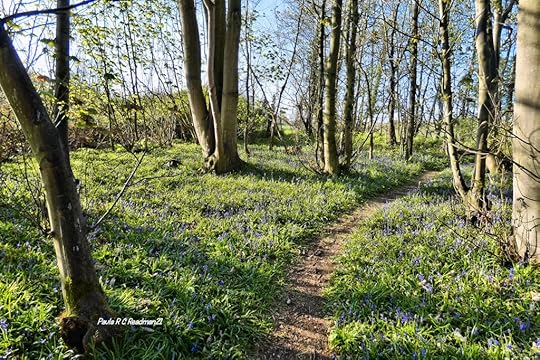
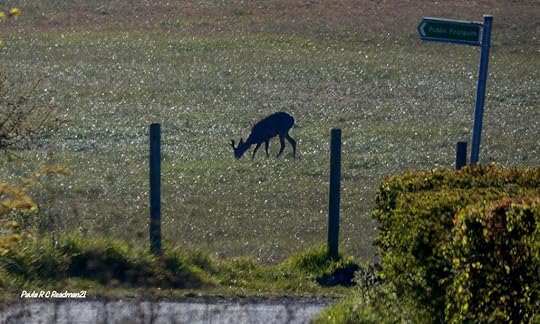

We followed the road until we found the next public footpath sign. This led us around a lovely little cottage (Deek’s Cottage) and onto a track that said it headed towards the airfield. The sun was warmer than we expected, so I was glad that I only had a thin jumper on under my jacket and hadn’t wore my woolly hat or gloves as I had on previous mornings.

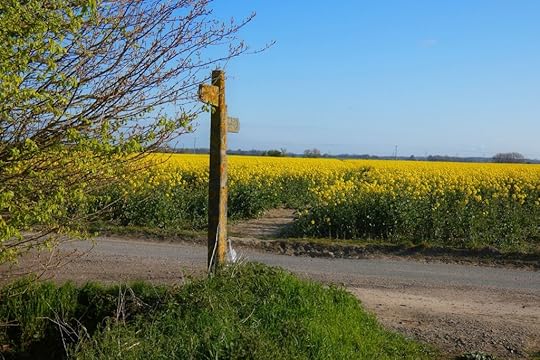

 We followed a track between the fields which we hoped would taken us towards the airfield. The edge of the track was filled with English bluebells, primroses and stitchwort. The walk was quite magical as we imagined in the past villagers using these ancient tracks and bridleways to get from one places to another before the roads were built. Many of these paths have been walked into existence over the centuries. In 1968 the British parliament required the county councils to signpost all public footpaths and bridleways across the country.
We followed a track between the fields which we hoped would taken us towards the airfield. The edge of the track was filled with English bluebells, primroses and stitchwort. The walk was quite magical as we imagined in the past villagers using these ancient tracks and bridleways to get from one places to another before the roads were built. Many of these paths have been walked into existence over the centuries. In 1968 the British parliament required the county councils to signpost all public footpaths and bridleways across the country. On seeing Felix Hall clock tower across the fields I realise we had taken the wrong path and we had to turn back the way we came. We soon arrived at Allshot farm and was able to walk through to Woodhouse farmyard again. The walk took us 3 hours and 37 minutes.
It was a wonderful walk.
The only down side was I was wearing new boots. By the time I arrived home and took them off I discovered just how bad my discomfort was on seeing how much damage a blister had done to one of my heels. Now I must wait until it heals before we can venture out again.
1 slide) Felix Hall Clock Tower: 2) back the way we came 3) Old building on the Airfield 4) inside one of the farm buildings 5) Woodhouse Farm house 6) detail on old door
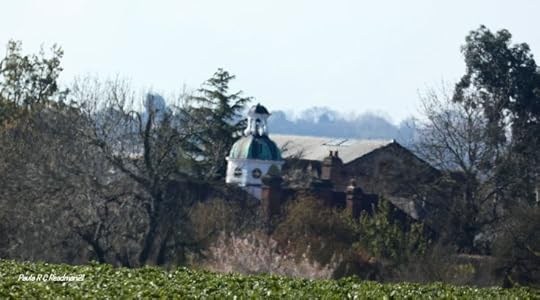





There was I looking through…
There I was looking through the latest writing magazine thinking about sending in post about my soon to be released second novel, Seeking The Dark when I came across a piece about a writing friend of mine.

Dawn Knox and I are both published authors and have been writing for Bridgehouse Publishing’s anthologies for many years now. It was lovely to read about her success in The Writing Magazine. Dawn had joined forces with another writer, Colin Payn to write a post-apocalyptic book. It must have been tough for them to work together on their joint writing adventure during the pandemic as they could only meet up online to discuss any issues they had while working on their project. Their amazing book, The Future Brokers is quite achievement, and is now available to read.

As I carried on flicking through the magazine another face jumped out at me which I hadn’t expected to see 
 Does it look familiar to you?
Does it look familiar to you?

It’s rather stormy here today. Very windy. Hopefully the weather will settle down and I can start planting my vegetables out. I shall plant them under glass this coming week.
May 3, 2021
Book Launch Chat: Alison Knight
Welcome to Clubhouse Chat page. Those of you who are not a member won’t be aware that the location of the Clubhouse is shrouded in mystery. The only way to visit it is via membership or an invite to the tearoom. Every few days, I’ll be sharing a conversation with all sort of writers and authors at different levels of their writing careers. Over tea and cakes, or maybe a glass of something stronger, I shall be chatting with my guest about their work in progress, or latest book release.
 Photo by Valeria Boltneva on Pexels.com
Photo by Valeria Boltneva on Pexels.comToday, I’m chatting to Alison Knight on the launch of her book. The Legacy. An unexpected inheritance. A web of deceit. A desperate escape.
London, 1969.
James has his dreams of an easy life shattered when his aunt disinherits him, leaving her fortune to her god-daughter, Charlotte. He turns to his friend, Percy, to help him reclaim his inheritance – and to pay off his creditors. But when their plans backfire, James becomes the pawn of Percy and his criminal associates.
Charlotte is stunned when she is told of her windfall. After an attempt at cheating her out of her inheritance fails, James tries to intimidate her. But she is stronger than he thinks, having secrets of her own to guard, and sends him away with a bloody nose and no choice but to retreat for now.
Resigned, James and his spoilt, pampered girlfriend, Fliss, Percy’s sister, travel across France on a mission that promises to free James from the criminals for good. But James isn’t convinced he can trust Fliss, so he makes his own plans to start a new life.
Will James be able to get away, or will his past catch up with him? Will Charlotte’s secrets turn the legacy into a curse?
Welcome to the tearoom, Alison and your book sound amazing.
Thank you for the invite to the Clubhouse tearoom to help celebrate the launch of my book, Paula.
You’re very welcome, Alison. Let’s start by asking you, did you try to be more original when writing this book, or deliver what you felt the readers wanted?
I was driven by a desire to follow a path to see where it led. My previous book, MINE, was based on real events in my family in the 1960s but there were gaps in my knowledge of what happened that couldn’t be filled because the people involved are no longer around to tell me what actually happened, so I had to use my imagination to fill those gaps. One fictional scene involved two of the main characters, Lily and Leonard, visiting a Miss Jarvis in a nursing home in order to witness her Will. She had changed it to effectively disinherit her nephew, James, and leave her God-daughter, Charlotte, the fortune he had been expecting her to leave him. After I’d written it, I began to think about how James and Charlotte might have reacted to this, and that’s how THE LEGACY came into being. I wanted to know why James had been disinherited and how that changed his life. I also didn’t want Charlotte’s story to be quite so sweet and wholesome as we first think. That’s why the legacy is a both a curse and a blessing.
Did you feel energised or exhausted after writing this book?
Definitely energized. Writing MINE had been very hard as it was a story so closely linked to my own life so I welcomed having to concentrate on writing THE LEGACY after that. It was also the quickest book I’ve ever written – it took less than six weeks to finish the first draft whereas I’d taken decades to write and rewrite MINE until I felt it was right. Other books I’ve written took several months and sometimes years as I had to write them in between bringing up a family, working full-time and often studying as well (I went to university in my mid-forties and achieved a first class degree in Creative Writing and an MA in the same subject over several years, studying part-time). I’m in a fortunate position now of being a semi-retired empty-nester, so I have more time to focus on my writing.
Do you want each of your books to stand alone, or are you building a body of work that are interconnected? Whether that be a theme, a set of characters, a setting, etc. Explain more for our readers.
THE LEGACY is a stand-alone story, but it does start with a repeat of the will-signing scene from MINE and makes a couple of nods towards that story, including a later appearance by Lily, so they can be read together. Also, my current work in progress is another stand-alone story which is set in another country and follows what happens to one of the secondary characters in THE LEGACY. So although all three books can be read alone, I hope people will read all of them and enjoy the links between them.
 Alison Knight
Alison KnightHow do you balance your demands on the reader with taking care of your readers? In the book did you spell everything out so your reader just had to read it, or did you rely on their emotional response to your words?
I always hope that my readers will have an emotional response to my books, although I was aware that people might be upset by what happens in MINE. Thankfully, everyone has been very kind and appreciate that there could have been no other ending as it is based on real events. In THE LEGACY, that’s not the case, but I hope my readers will engage with the characters and understand why they are how they are. My aim is for readers to care about what happens to them.
Do you hope your book will deliver you literary success and how will this look to you?
Literary success for me is good reader feedback. It would be nice to win awards and sell lots of books, but it’s more important for me to tell a good story that my readers appreciate. I want people to read my stories and love them so much that they tell their friends, who then read them and tell their friends and so on.
Was there anything you edited out of this book, you wanted to keep in, but you knew it would be a better book by cutting it?
Actually, no. It’s the first book I’ve written that didn’t need major edits or rewrites.
How long did you spend researching this book’s subject matter, or was it a book you had already planned?
I already had some knowledge of wills and probate as I was a Legal Executive for over a decade and the legislation and processes weren’t very different between the 1960s and when I trained in the late 1970s. I had also done a lot of research into life in the 1960s to supplement my own childhood memories of that time when I was writing MINE. So I was ready to go with THE LEGACY, apart from some research into the links between criminal gangs and London casinos, and looking at attitudes to homosexuality in the 1960s – it was illegal until 1967, but even after that it was still extremely difficult for gay men, so few came out. I hope that doesn’t give away too much of the plot!

What was the hardest scene to write in the book?
There’s a scene where Charlotte, the main female character, is besieged by the press who are outside her flat, knocking on the door, peering through windows and trying to call her. She’s a mild-mannered school teacher who has never experienced anything like that before, so she’s traumatised by it. I’ve been in a similar situation and it’s not something I’d ever want to repeat, so writing it was tough. But I think it fits well with the plot, so it had to be done.
How will you cope with bad reviews on this book?
I’ll try not to take it personally, and if their criticism is a valid one, I’ll take it on board. However, I’m a sensitive soul, so I probably will worry about them. I realise that everyone is different and we all have our own likes and dislikes, This story is pure fiction but I try to make it as realistic as possible so if it’s not to someone else’s taste, I’m sorry. But I hope more people will like it than hate it.
What’s the one thing you would give up to become a better writer?
Wow! That’s a hard question. I know I’m not perfect and am always striving to become a better writer. But I’m not sure what I could give up to achieve that. I think it’s more a case of doing more rather than giving something up, so maybe I would have to say that I’d spend less time procrastinating and more time writing in order to become a better writer!
Thank you for the invite and it’s been great fun.
Congratulations on the launch of your book, Alison. The tearoom wishes you many sales.
Please check out this link to buy the book: mybook.to/legacy.
If you want to find out more about Clubhouse Member’s Books don’t forget to check out the Clubhouse Bookshops too.
April 29, 2021
Gooseberries and Bluebells

We followed the paths to take us the woods, Rivenhall Thicks, and Tarecroft Wood. The walk took 127 minutes and we needed to walk briskly as it was a chilly morning. The hedgerow is now edge with tiny white flowers of the greater stitchwort. The plant’s name comes for the fact it was thought to be a cure for the ‘stitch’, a pain in the side of the body.
 Greater Stitchwort
Greater StitchwortCrab Apple: The flowers are in clusters of about five to seven, each with five sepals, hairy inside, and five petals. The yellowish-green fruit is very sour and is used to make crab-apple jelly.
Gooseberries: The plant was native in most of Europe and ground in shady valleys and rocky woods.
Wood Melick: A delicate creeping perennial grass of dry, shady woodland.
 Crab-Apple
Crab-Apple
 Gooseberries
Gooseberries
 Wood Melick
Wood MelickThe bluebell are now in full flower in Tarecroft woods. As we followed the path through the wood I heard high above us a loud ‘chwit’ and spotted a Nuthatch. The small blue-grey bird with buff underparts hopped up and down the tree trunks in search of insects. It moved too quickly for me to get a clear shot of it. Blue tits and Great tits were all busy hunting for insects too.
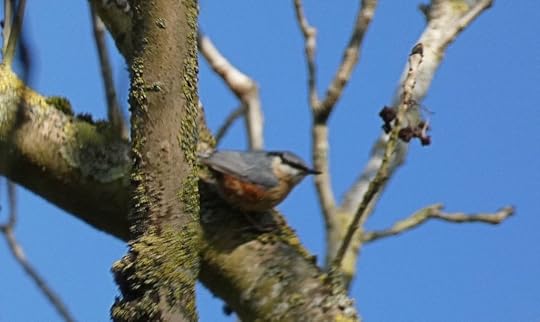 Nuthatch
Nuthatch
 Blue tit
Blue tit
 Great tit
Great titHopefully we will have some warmer mornings soon as it is still too cold for many insects and plants which we have seen other years at this time of the year. I’m hoping we will have some rain too as it is very dry and my water-butts in the garden are getting low already.

Chat again soon,
April 28, 2021
A Walk to Rivenhall Church (The Long Way Round)
On a chilly morning with the promise of a bright sunny day ahead of us we set off on a long walk. We crossed the old airfield and saw the growing new houses that are spreading across the meadows where we once walked. We took the path that carried us passed the polish camp.
I heard the drumming noise high up on a tree and saw a hole. The rapid hammering stopped and a face of a great spotted woodpecker appeared in the hole. False Oxslip is a hybrid between the cowslip and the primrose. Bugloss is a member of the forget-me-not family. The name of the plant comes from the Greek word meaning ox-tongued and refers to the shape and rough texture of its leaves.
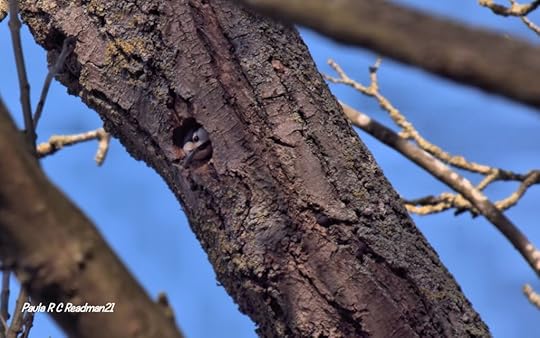 Great spotted woodpecker
Great spotted woodpecker
 False Oxslip
[image error]
Bugloss
[image error]
Yellow Hammer
[image error]
Swallows back from Africa
False Oxslip
[image error]
Bugloss
[image error]
Yellow Hammer
[image error]
Swallows back from AfricaAfter leaving the Polish Camp, we walk passed Porters Farm and turned onto the bridleway. The bridleway is known as Sniveller’s Lane takes you down to Crane’s Lane and then on the A12. We only walked as far as the Footpath mark.
 The footpath marked
The footpath marked
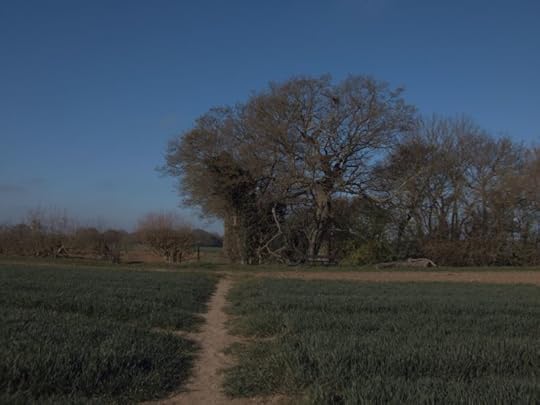 The path towards the church.
The path towards the church. 
We followed the footpath down across the field with its wonderful views towards Silver End. Once we reached the church we stopped to have a look around. The church’s foundations dates back to Anglo-Saxon times. A small excavation against the south wall of the chancel was carried out in the 1970’s. The results showed there was evidence that the site was occupied from the late Iron Age, and above this level there were remains of a first century A.D. roman masonry building. There has been Christian’s worship at Rivenhall church from beyond the earliest recorded date of 1185.
 [image error]
[image error]




On leaving the church we walked along the edge of the field. The view back to the church and school is lovely. We cut through Rivenhall Place taking the footpath down by the lake and back into Western Lane to make our way home. It was a lovely long walk.
 Cow parsley
[image error]
spider and ground ivy
Cow parsley
[image error]
spider and ground ivy
 Peacock Butterfly
Peacock Butterfly
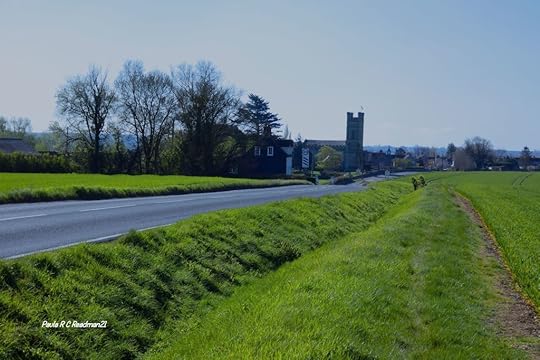 View to Rivenhall, Essex
[image error]
RobinI’m a bit late in posting this as I’ve been rather busy just lately.
View to Rivenhall, Essex
[image error]
RobinI’m a bit late in posting this as I’ve been rather busy just lately. I shall catch up with you again soon.
April 27, 2021
Granny’s Cottage in the Woods
Last Saturday on my village Facebook site, someone posted a photo of a cottage half covered in ivy. It intrigued me. There’s something so unexplainable about abandon buildings and ruins which intrigues us all that we are drawn to visit them for ourselves. I guess we all what to know the stories behind why these places have been forgotten.
The farm cottage in my photo (below) was once part of a farm that was taken over the government during the Second World War. I had seen photos of the main farmhouse before, but I hadn’t realise there was another building on the site. The cottage caught my attention and really fascinated me.
On a chilly Monday morning, my friend and I set out for a walk to see if we could photograph the buildings for ourselves. I hoped too that the buildings inspire more settings for my Granny Wenlock’s books. I needed to photograph them straightaway because the site is due to be developed. There’s a waste incinerator and a new main road on the local planning office’s books to be built on the site over the next few years .
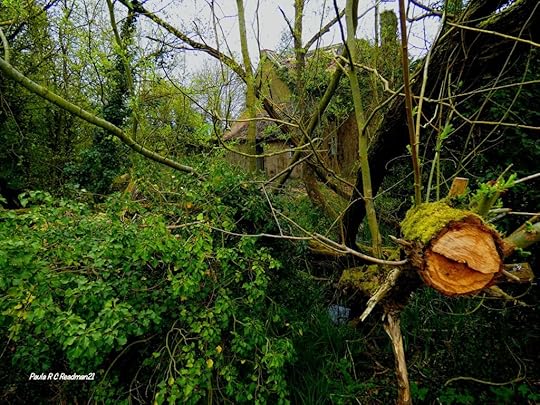 An amazing setting for murder, mystery and mayhem.
An amazing setting for murder, mystery and mayhem.
Of course, the cottage is too modern to be Granny’s though there has been a building on this site for a long time. In the late 16th century rural England became a scene of changes. A drop in population due to several outbreaks plague pandemics and civil wars brought a new way of living to many who lived on the land around my village. As life was better for rich and poor an increase in a growing population created a demand in home-grown food, while the people at that time were still importing spices, salt and tropical fruits. 17th century England was also beginning to develop new ways of farming too.
 Woodhouse Cottage (back)
Woodhouse Cottage (back)
I feel that Granny Wenlock’s home would be more like the picture below. Though more of a single storey building with the same timber frame, plastered walls and a thatched roof. Through my research so far there are several location where her home could be set. The idea that Granny’s home could have a moat is a delightful one.
 Googled from
Current Archaeology site:
This 1954 photograph, showing a now-demolished cottage at Long Crendon, Buckinghamshire, gives a good sense of what a Medieval peasant house might have looked like before 20th-century. Though I imaged Granny Wenlock’s home wouldn’t be so grand.
Googled from
Current Archaeology site:
This 1954 photograph, showing a now-demolished cottage at Long Crendon, Buckinghamshire, gives a good sense of what a Medieval peasant house might have looked like before 20th-century. Though I imaged Granny Wenlock’s home wouldn’t be so grand.
Records that I’ve uncovered, via the internet and my husband’s collection of books of the local area, shows that the main farm house dates back to the early 17th century and is a moated on three sides. We saw signs of the moat around the back of the cottage and to get to the cottage itself you had to cross a concrete bridge with a broken handrail. The moat itself was overgrown with reeds and shrubs. The main farmhouse originally had handmade red roof tiles which must have looked stunning against the white plaster, but now has a tin roof to try and protect the building from the elements.
 Woodhouse Farm House (Front)
Woodhouse Farm House (Front)
 Woodhouse Farm House (back)
Woodhouse Farm House (back)During the WWII the Woodhouse farmland was reduced from 270 acres to just fifty when an airfield was built to station both American and British forces to help in the fight to free Europe from the Nazis. The last fifty acres around the airfield was farmed by various owners throughout the war, with the help of the women’s land army, and some of the service personnel on their off duty moments.
I’m just very disappointed that I couldn’t find out anything more about the people who lived in both of the houses over the years. I know the farm was once part of a large estate belonging to Felix Hall which isn’t that far from Woodhouse Farm.
Charles Callis, Baron Western 1767-1844 inherited Rivenhall Place, a large estate just outside my village, also owned Felix Hall in 1790 as it was his main place of residence and where he died in 1844. Charles was an avid collector, traveller and antiquarian, but his main interest was in the improvement of farming methods, such as improving the breeds of sheep.
 Felix Hall
Felix Hall
It was a very interesting walk, and to find another stunning location too. Now I really must stop researching get on with the writing. I’ve uncovered a lot of information around this area, and places to set future tales, but now I must put it all into some order down on paper, and just get on with the writing.
Have a great day and keep safe everyone.
April 25, 2021
Book Launch Chat: Miriam Drori
Welcome to Clubhouse Chat page. Those of you who are not a member won’t be aware that the location of the Clubhouse is shrouded in mystery. The only way to visit it is via membership or an invite to the tearoom. Every few days, I’ll be sharing a conversation with all sort of writers and authors at different levels of their writing careers. Over tea and cakes, or maybe a glass of something stronger, I shall be chatting with my guest about their work in progress, or latest book release.

Today we are celebrate the launch of Miriam Drori ‘s novel, Style and The Solitary. Welcome to the tearoom, Miriam.
Thank you for having me back, Paula.
Let’s start by asking you when writing Style and the Solitary did you try to be more original when writing this book, or deliver what you felt the readers wanted?
Interestingly, I’ve found that rules or guidelines, rather than restricting my writing, actually make it more unusual and original. When I wrote a romance, I chose an unconventional topic. In my series of flash fiction stories in which the sentences in each story begin with the same letter, this self-imposed restriction led me in unexpected directions. And my new crime story, Style and the Solitary, is also quite unique in some ways.
Did you feel energised or exhausted after writing this book?
I felt energised. I wrote it in November for NaNoWriMo, the month when a lot of crazy authors around the world try to write a novel in a month. In my local group, the leaders advised waiting at least a month before starting to edit our novels. I waited two days. I’d surprised myself by reaching the 50,000-word target, and was excited about finishing my first crime novel.
 Miriam Drori
Miriam Drori
Do you want each of your books to stand alone, or are you building a body of work that are interconnected? Whether that be a theme, a set of characters, a setting, etc. Explain more for our readers.
I intend this book to be part of a series, in which some of the characters, including the setting, return along with new ones. However, each book in the series will stand on it own as a crime novel. None of them will end on a cliffhanger.
How do you balance your demands on the reader with taking care of your readers? In the book did you spell everything out so your reader just had to read it, or did you rely on their emotional response to your words?
I don’t spell everything out. I’m sure my readers are intelligent enough to work some things out for themselves. But I don’t like to confuse anyone, just as I don’t like to be confused by a book I’m reading.
Do you hope your book will deliver you literary success and how will this look to you?
Naturally, I want literary success. One way this could look would be invitations to give talks on social anxiety. (The novel isn’t just about social anxiety, but it’s included and I’m passionate about raising awareness of social anxiety.)
Was there anything you edited out of this book, you wanted to keep in, but you knew it would be a better book by cutting it?
Not this time, but there was a previous version, written a few years ago. That one included a longish chapter in which one of the main characters learned about social anxiety. The story didn’t need it.
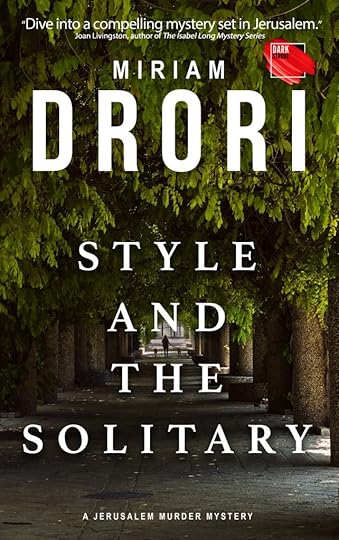
How long did you spend researching this book’s subject matter, or was it a book you had already planned?
Even though the book is set in a place I know and involves characters I made up, a lot of research was involved. I found the characters places to live. I read about Ashkelon and Strasbourg, where the main characters come from. There were all sorts of details in the story that I had to learn about.
What was the hardest scene to write in the book?
There isn’t one scene that stands out as being hard to write.
How will you cope with bad reviews on this book?
I think I’ve become immune (mostly) to bad reviews. As long as there are some good ones, I’ll be happy. No author can please all readers all the time. Besides, most bad reviews are not about the writing.
What’s the one thing you would give up to become a better writer?
I don’t know. Over the past year, I’ve had more time to spend on my writing, reading and promoting. Instead of going out to folk dancing three evening a week, I’ve spent every evening at home. Trips abroad have gone and visits to and by friends have all but vanished. But activities inspire writing. If this existence continued much longer, my writing would probably suffer. Consequently, I don’t think there’s anything I would give up.
Thank you for joining me today, Miriam. Good luck with your sales. To check out more of Miriam’s writing click on the links below:
April 22, 2021
Pear Tree Blossom and Bluebells
 English Bluebells and Dog’s Mercury
English Bluebells and Dog’s Mercury A chilly morning walk took us to Tarecroft woods again. The bluebell are now in flowers, along with the primroses and Dog violets.
On the way to the woods, I spotted a tall tree covered in white blossom. On closer inspection, I thought it was a crab apple tree, but I wasn’t sure. So I took some photos to check in my books once I got home. I’m glad I did. I found out that a crab apple blossom has a pink edge to it, while the wild pear tree blossom is pure white. Wild pears are hard and sour but as winter approaches they soften and become sweeter. it is the birds that sown the seeds of the wild pears. The trees can grow to 40ft and live for 60 years.
John Lawrence, rector of Yelvertoft, Northamptonshire, in the reign of queen Anne started to cultured the garden pear. He wrote a fascinating account of his endeavours in The Clergyman’s Recreation, published in 1714.
A cider-like drink made with fermented pears called Perry was drunk by the Normans who introduced it into Britain by them. The old names given to this drink was merry-legs or devil-drink as it was very potent.
 Leaves of the Wild Pear
Leaves of the Wild Pear
 Bark of the Wild Pear
Bark of the Wild Pear
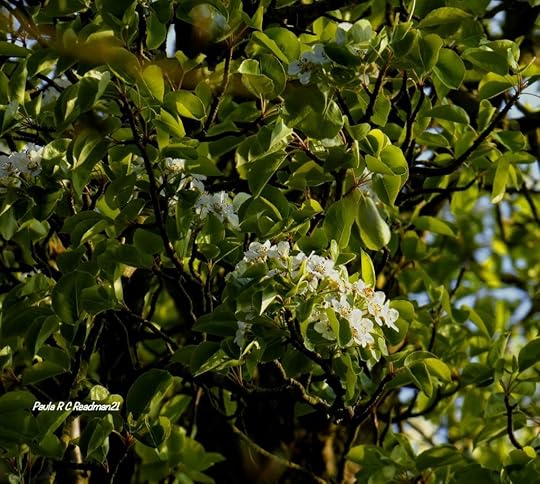 Blossom of Wild Pear
Blossom of Wild PearDryad’s Saddle or Pheasants Back : polyporus squamosus is a non-gilled bracket fungi. The name “dryad’s saddle” refers to the creatures in Greek mythology called dryads. Dryads were woodland tree nymphs or tree spirits who are shy creatures. Drys means oak in Greek though the fungus grows on trunks, stumps old timbers of deciduous trees especially elm, ash, pear. The fungus’ spores are spread by small beetles that are found in the fungi body. The common name pheasant’s back derives from the pattern and colours found a pheasant’s back.
 Dryad’s Saddle
Dryad’s SaddleRobin: Yesterday, as on any given day in early Spring, while out walking along the hedgerows and through the woods you will hear the sweet warbling from the cock robin in the tree tops. The cock robin is very territorial and guards it fiercely from another other robins who try to move in.


Today I’m off to do some work in the garden. It’s sunny but cold here. We are having a cold dry spring here in England.
Have a great day.
April 20, 2021
The Day of Reckoning.
There’s a saying that dates back to Elizabethan times about ‘Every dog will have its day.’ This means we all have a chance to shine, if given the opportunity, or we are determined enough to overcome any obstacles that may block our way.
Here’s the next instalment of my time as a mature student at a local college in 2005, when I first set off on my writing journey to become a published author.
 Photo by Pixabay on Pexels.com
Photo by Pixabay on Pexels.comDay 5 of 32 Weeks: The Day of Reckoning
Once again, I arrived early to find two of my classmates already there. They were deep in conversation about holidays. I left them to it, and sat by the window on my own while we waited for the door to be opened.
The next to arrive was Ms Bright Smile; I asked her why she had already spent a year on this course. She explained she had a problem with reading, couldn’t read the questions quick enough, and to add to her problems the computer crashed on the day of her exam. Therefore, they had allowed her to take the course again. I asked her what she thought of Mr C’s abilities to teach.
“He’s laid back, isn’t he?” she said.
“I’m finding it unnerving when he tells us he doesn’t understand grammar. How on earth can I possibly understand it all, if the teacher can’t?”
She laughed. “Yes, I know, what you mean.”
Then Mr C arrived. “I’m two minutes early,” he said brightly.
“How very unlike you,” Ms Bright Smile said laughingly.
“This week I’m more organised,” Mr C said as he sat down at his desk. Then he started telling us about a class he took on Tuesday. They had talked about what were the most important things that had been invented in the last two hundred years.
Ms Bright Smile interrupted him and said. “What has that got to do with us?”
“Oh, I just thought it was interesting. We decided it was the plastic shopping bag. It’s just something you don’t think about.
“And?” said Ms Bright Smile.
“I thought it was interesting, that’s all. Anyway, okay. To start with we’ll look at prepositions,” he said as he handed his ubiquitous BBC Skillswise worksheets to the class.
“Now prepositions are quite simple. They tell you where things are. The time as in for, since, ago and before, and there’s not a lot more that you can say about them. They are not as exciting as nouns. Right now, here’s an exercise you can do, if you want to. It’s up to you. Can anyone tell me what an adjective is?”
Someone said, “It’s a describing word, isn’t it?”
“That’s right, it’s a describing word. You couldn’t write anything without them. Now I would like you to write a short… Err, no, err, right think of a person, and then describe them, using adjectives.”
Mr C made his way around the class asking each of us to describe the person we had thought of. He then stopped and started to talk about Claire having a new car. Then stopped again and started talking about where you needed to place the adverb. He changed the subject again, and said, “No, you can’t say that… mmm, right okay. I would like you to write a description without adjectives.
We all looked from one to another quite unsure what was going on.
Mr C laughed. “Okay, that was a trick, you can’t do it. Writers use them all the time. I’ve a short story I’d like to pass around for you all to read. I didn’t like it. Maybe I should have made more copies. Okay, I won’t do that. Right, here’s a list. I’ve not heard of this before. It’s known as ‘The Dolch List’.”
Mr C handed out another sheet with two lists on it. A list of important everyday words e.g. On, off, salt, sugar, Tea, Coffee, Front, Back etc. A list of important words e.g. A, I, It, the, All, be, for, his, on, so, etc.
Then he talked about poetry, telling us they are important and they use adjectives. “Poems don’t have to rhyme, though they do have to be written in a certain way.” He handed a sheet with a poem written by Spike Milligan. “I’m sure you all know who he is,” he said brightly.
 Photo by Talha R on Pexels.com
Photo by Talha R on Pexels.comWe read the poem, and Mr C told us he found writing poems difficult, but if any of us would like to have a go, please do try.
“Right, I would like you all to write a paragraph using adjectives. From one of these three: (A) A lady going upstairs.
(B) A man crossing the road.
(C) A bottle of milk falling down a step.
(D) A Cat drinking milk.”
Yes, I know there are four in the list, but he said three and wrote four. After we all sat writing out our short paragraphs we had to read them aloud. When he worked his way around the class and finally got to the Lady G who was sitting next to me. As she started to read hers out aloud, I noticed instead of using adjectives she had been using words from the list of prepositions.
Mr C gave out some exercises for the class to do, and gave me a short story to read through. I gave him my synopsis in exchange; he smiled and said it looked interesting.
While the rest of the class disappeared for the smoke break I asked, Lady G what she thought of Mr C? She sighed and said “I can’t keep up with him he’s all over the place.”
The young man called M join us in our chat, and said the same. I said “I was glad to know that it wasn’t just me.”
Once the class had returned and Mr C set everyone to work. He came to me to see what I thought about the short story. I told him I hadn’t finished reading it, but I did have a complaint. He breathed in deeply and said “Oh no.”
I told him, I found it hard to keep up with him as he leapt from one thing to another. I got confused and explained that when he was talking about adverb at the end of the last lesson I thought you just added ‘–ly’ to the word. However, when I worked through the notes, he had given us at home, I understood far more.
When Lady G, Young M, and I had been talking in the smoke break, Young M had explained to us that where you placed the word within the sentence also changed the word and meaning.
Taking the sentence: The girl smiled beautifully.
Verb, adverb
The girl had a beautiful smile.
Adjective, noun
The girl is smiling beautifully
Verb adverb
Verb = adverb
Noun = adjective.
Once Mr C wrote it out on the board it made it a lot clearer. Even the classroom assistant said to Ms Bright Smile, “This is what you need to understand too.”
By the end of the lesson, he said he would slow down and make sure that we were all keeping up. I’m glad I told Mr C what I thought. Though, he did say on our first lesson he didn’t like writing things out on the white board. I do find I understand things much clearer when I can see how a sentence is constructed.
After everyone else had left, he went through part of my synopsis with me. He was very helpful, and I can now see I have a lot to learn about writing.
Mr C said, “Don’t you worry, we’ll have you winning the Manbooker Prize in no time at all.”
(I’m not sure whether this was said in jest or not )
)
Next week is half term, so I’ll be working back through everything I’ve learnt so far. Yes, I know, not a lot.
Dear Readers,
I hope you are keeping up with all of this  Be warned, I might start asking questions soon. Though this might just be my cry of desperation
Be warned, I might start asking questions soon. Though this might just be my cry of desperation 
~~~~~~~~~~
Have a great day Everyone. I’m off for a walk now.
I look forward to reading your comments.



